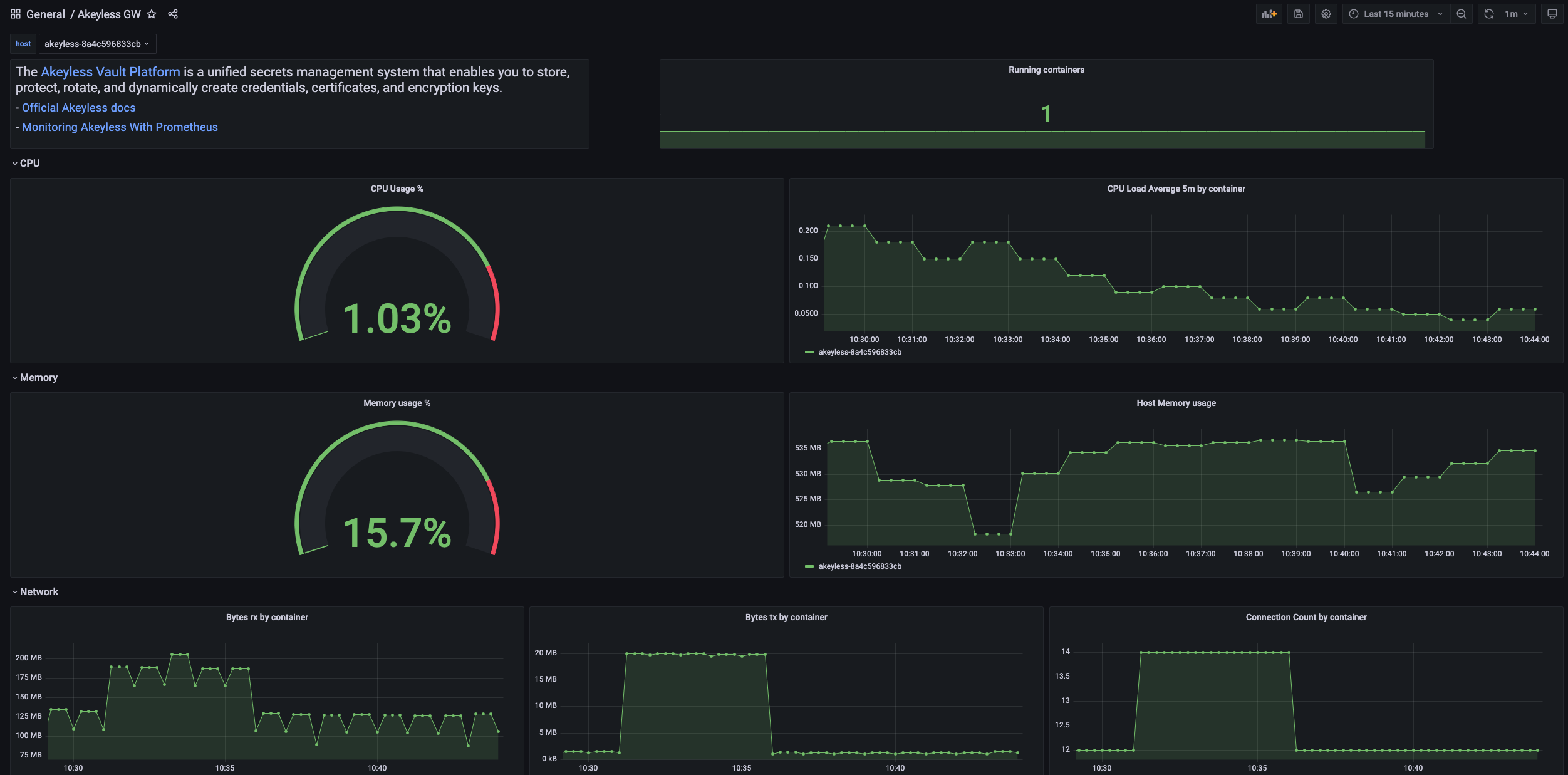Telemetry Metrics on Kubernetes
For Kubernetes Environments
Akeyless Gateway Telemetry Metrics can be consumed by well-known monitoring and alerting solutions, such as Datadog or Prometheus. You can find a full list of supported endpoints on the official page of the OpenTelemetry project.
The Telemetry Metrics are based on time series telemetry data metrics from the application and the runtime environment, storing them in a unique database or index, and analyzing data trends over time.
The metrics visualization uses a pre-made/custom dashboard (Grafana Marketplace dashboard, Datadog integration dashboard, etc.).
The following Metrics are currently available:
| Metric | Description |
|---|---|
akeyless.gw.system.cpu.* | CPU utilization metrics |
akeyless.gw.system.disk.* | Disk I/O metrics |
akeyless.gw.system.load.* | CPU load metrics |
akeyless.gw.system.memory.* | Memory utilization metrics |
akeyless.gw.system.network.* | Network interface I/O metrics & TCP connection metrics |
akeyless.gw.system.saas.connection_status | Monitor the connection of the Gateway with all Akeyless SaaS services. |
akeyless.gw.quota.current_transactions_number | The current total transaction count in the account |
akeyless.gw.quota.gw_admin_client_transactions | Total transactions made by the Gateway default identity (AdminAccessID) |
akeyless.gw.quota.total_transactions_limit | Total transaction limit per hour in the account |
akeyless.gw.system.http_response_status_code | Status of HTTP response for any request that originates from the Gateway API. (i.e. performed against the Gateway) |
akeyless.gw.system.request_count | Total number of requests that were issued directly against the Gateway API (the count of total HTTP status) |
akeyless.gw.system.healthcheck.status | Monitors container health check status |
Datadog
To enable Telemetry Metrics on your Gateway for Datadog, edit the chart values.yaml file under the metrics section and set your metrics backend configuration:
metrics:
enabled: true
config: |
exporters:
datadog:
api:
key: "<Your Datadog API key>"
site: <Your Datadog server site>
service:
pipelines:
metrics:
exporters: [datadog]Set the relevant API Key of your Datadog server, and set the relevant site. If your Datadog server is running in the EU site, add site:datadoghq.eu. By default it is set to the US site. If you did this before deploying your Gateway, go to Dashboard Setup. If you are adding this to a running Gateway, update your Gateway once done and continue to Dashboard Setup.
Dashboard Setup
Akeyless is an official Datadog Partner and our dashboard can be found inside the Datadog app.
-
Go directly to your Datadog account and click on Integrations --> Integrations. Then choose Akeyless Gateway from the list of Integrations and click the Install Integration button.
-
Once installed, go to Dashboards --> Dashboard List and choose the Akeyless GW Dashboard that was installed.
-
If your Gateway metrics are up and running properly, you will see your Gateway metrics in the Akeyless GW dashboard. You can also go to the Metrics Explorer to see more metrics to add to the Dashboard by filtering for
akeyless.gw.
Prometheus
To enable Telemetry Metrics on your Gateway for Prometheus, edit the chart values.yaml file under the metrics section and set your metrics backend configuration:
expose the port 8889 (or any other port) for Prometheus Exporter and the Prometheus Scraping as described below:
service:
annotations:
prometheus.io/scrape: "true"
prometheus.io/port: "8889"
metrics:
enabled: true
config: |
exporters:
prometheus:
endpoint: "0.0.0.0:8889"
service:
pipelines:
metrics:
exporters: [prometheus]Add a scraping target for the Akeyless Gateway in your Prometheus config file and restart your Prometheus server.
scrape_configs:
- job_name: 'akeyless'
scrape_interval: 10s
static_configs:
- targets: ['localhost:8889'] Once done, check your Prometheus server for the ingested metrics.
Grafana Dashboard
You can visualize Akeyless metrics in Grafana Dashboard when using Prometheus as a data source.
Import the Akeyless Gateway dashboard for your Grafana instance using this link.

Using Kubernetes Secret
Create a Kubernetes Secret with the relevant settings of your target metric server and save it to a file config-secret.yaml:
exporters:
datadog:
api:
key: <api-key>
service:
pipelines:
metrics:
exporters: [datadog]exporters:
prometheus:
endpoint: "0.0.0.0:8889"
service:
pipelines:
metrics:
exporters: [prometheus]Encode the file to base64:
base64 --input=config-secret.yamlCreate a Kubernetes Secret using the encoded value and place it in the data.otel-config.yaml section:
apiVersion: v1
kind: Secret
metadata:
name: gw-metrics-secret
namespace: <your-namespace>
type: Opaque
data:
otel-config.yaml: <Base64 Kubernetes Secret value>Deploy the secret on your Kubernetes cluster, and make sure to deploy the secret to the correct Namespace:
kubectl apply -f secret.yaml -n <your-namespace>Set your Kubernetes Secret name on the metrics.existingSecretName field in the Gateway chart values.yaml file:
metrics:
enabled: true
existingSecretName: "gw-metrics-secret"Gateway Application Log Forwarding
To collect the Gateway application logs with the metrics you can set an additional exporter endpoint and service, for example:
Edit the Gateway values.yaml file as described below:
metrics:
enabled: true
config: |
exporters:
prometheus:
endpoint: "0.0.0.0:8889"
loki:
endpoint: "http://loki:3100/loki/api/v1/push"
service:
pipelines:
metrics:
exporters: [prometheus]
logs:
receivers: [filelog]
processors: [batch]
exporters: [loki]
env:
- name: FORWARD_GW_APP_LOG
value: "true"Where the new Loki endpoint is set with a new service for logs, using filelog as the receiver and loki as the exporter.
To add the Gateway Cluster unique identifier to your logs set the FORWARD_GW_APP_LOG="true" environment variable.
Application Logs from all instances of this gateway will be forwarded in this format: <date> <time> <gw-clustername-instance-id> <log>.
After starting the Docker container, you can utilize Loki Grafana to query logs effectively. Follow these steps:
-
In Grafana, navigate to Data Sources and add a new Loki Data Source
-
Once the data source is configured, go to the Explore section
-
In the Label Filter, select Exporter and OTLP to filter the logs accordingly
This will enable you to monitor and analyze your application logs seamlessly.
Alternatively, you can store a Kubernetes Secret to store the relevant otel-config.yaml as described in the Using Kubernetes Secret.
Metric Tag Configuration
You can also add tags to metrics using OpenTelemetry semantic conventions, more information can be found here.
Updated 11 days ago
